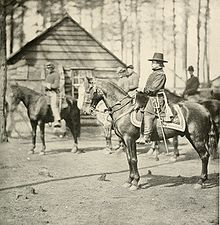Rufus Ingalls
Rufus Ingalls (born May 23, 1820 in Denmark , Maine , † January 15, 1893 in New York City ) was an American brigadier general in the US Army .
Life
Mexican-American War
After schooling Ingalls entered the US Military Academy in West Point and became after its completion in 1843 a second lieutenant in the Rifle Corps, but then in 1845 for the first dragoon regiment added. During the Mexican-American War from 1846 to 1848 he took part in the battles of Embudo and Taos and was promoted to lieutenant on February 16, 1847 . On January 12, 1848 he was promoted to captain and appointed deputy quartermaster of his regiment.
He then served with his unit in California and Oregon and took part in the expedition led by Colonel Edward J. Stedtoe through the North American continent. Between 1856 and 1860 he was a staff officer in Fort Vancouver , commanded by General William Selby Harney , and took part in the 1859 pig conflict.
Civil War and Post War
At the beginning of the Civil War he was transferred to Fort Pickens in Florida in April 1861 and then to the Army of the Potomac in July 1861 . On September 28, 1861, he was promoted to lieutenant colonel and appointed aide-de-camp to General George B. McClellan . He was then between January 1862 and the end of the Civil War in 1865 senior quartermaster of the Army of the Potomac. In this capacity he participated in the battles of South Mountain (September 1862), Antietam (September 1862), Fredericksburg (December 1862), Chancellorsville (May 1863), Gettysburg (July 1863) and the battles that followed until the surrender of the Confederate States Army attended by General Robert E. Lee .
On May 23, 1863 he was first brigadier general of the volunteer troops and in 1864 received the brevet rank of brigadier general of the US Army. In June 1864, Lieutenant General Ulysses S. Grant also assigned him the task of supplying the troops and, associated with this, the contract to build a large material depot in City Point . For his excellent service during the Civil War he was awarded the rank of major general on May 13, 1865 , before he was retired from voluntary military service on September 1, 1866.
A few months later he was accepted into regular military service in April 1867 and was as a colonel until July 31, 1876, quartermaster of New York City. After serving in divisions on the Pacific and Missouri , he took over this function again between March 1, 1881 and March 14, 1882, before he was then in the rank of Brigadier General 16th Quartermaster General of the US Army. In this capacity he was the successor to Brigadier General Montgomery C. Meigs and Daniel H. Rucker, who had only been in office for ten days . On July 1, 1883, he retired from active military service at his own request and was replaced as Quartermaster General by Brigadier General Samuel B. Holabird .
After his death he was buried with military honors in Arlington National Cemetery.
See also
literature
- Ingalls, Rufus . In: James Grant Wilson, John Fiske (Eds.): Appletons' Cyclopædia of American Biography . tape 3 : Grinnell - Lockwood . D. Appleton and Company, New York 1887, p. 346 (English, Textarchiv - Internet Archive ).
Web links
- Rufus Ingalls in the database of Find a Grave (English)
| personal data | |
|---|---|
| SURNAME | Ingalls, Rufus |
| BRIEF DESCRIPTION | American Brigadier General of the Northern States in the Civil War |
| DATE OF BIRTH | May 23, 1820 |
| PLACE OF BIRTH | Denmark , Maine |
| DATE OF DEATH | January 15, 1893 |
| Place of death | New York City |

